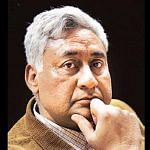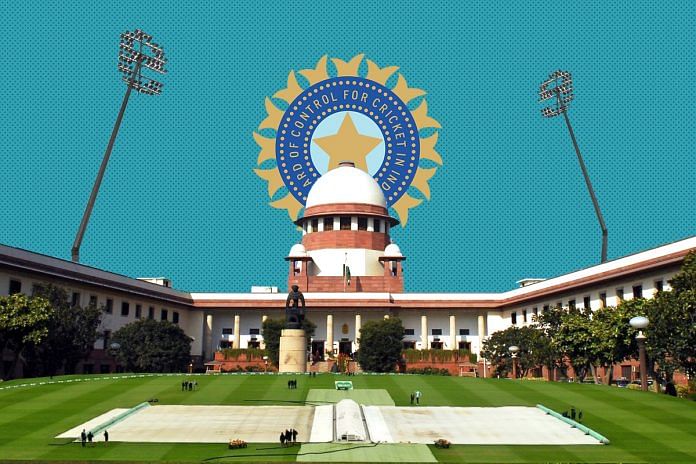The Supreme Court Thursday ruled on the BCCI’s draft constitution. While it reversed the ‘one state, one vote’ order it passed two years ago, it has retained several other recommendations made by the Lodha committee to clean-up the cricket administration.
ThePrint asks- SC’s BCCI rollback: Belated admission that meddling in cricket was a blunder or half retreat?
Revised SC order makes much more sense and is fair
 Ayaz Memon
Ayaz Memon
Senior sports journalist, columnist and commentator
When the earlier recommendation was announced, I had serious compunctions about the very points that the Supreme Court has now rectified. The revised order makes a lot more sense.
It was ironic that cricket associations like Mumbai, Vidharbha, Maharashtra, Saurashtra, Baroda and Gujarat, all of which have a long history and magnificent legacy – apart from having produced many quality cricketers – should be given a vote only by rotation while new ones (like some northeast states) would have an independent vote every year. In the effort to provide parity to all states, it cut the ground from under-established cricket centres.
The earlier order would have made associations from Mumbai, Baroda become feeble and ineffective. What’s the incentive for office-bearers from these associations to work if their clout is taken away and restored intermittently? The Supreme Court has done well to rectify this.
The ‘cooling off’ period for office-bearers was also contentious. Age cap on them is understandable. But a cooling period after just one three-year term was defeating the very purpose of wanting to get fresh blood and new ideas to run cricket. Why would anybody even deeply passionate about the game sacrifice three years of his/her life (without any financial consideration since these are honorary posts) if a second term is so distant or elusive?
Two successive terms allow an office-bearer – especially young ones – to see her/his idea and programme through till fruition. By extending the term to six years, the court has done well to ensure that cricket associations continue to grow.
The greatest challenge now is to make the inclusion of nascent cricket associations (like those from the northeast) productive. There will be hardships, but if robust programmes are put in place and pursued diligently, favourable results could follow in a decade or so.
Read more: SC goes back on Lodha’s ‘one state, one vote’ recommendation for cricket bodies
To see Supreme Court’s order as ‘solution’ is incorrect & misconceived
 Alok Prasanna
Alok Prasanna
Senior Resident Fellow, Vidhi Centre for Legal Policy
The Board of Cricket Control in India was and continues to be a dysfunctional body, but it is highly questionable if the Supreme Court should have taken up the task of reforming the body.
Given that more pressing issues of governance and human rights have taken a backseat in the court’s docket of late, an extraordinary amount of time and energy has been spent in trying to reform what is still a private body, although it does perform some public functions.
The court’s extended intervention might only reinforce the notion in people’s minds that the institution is for “men with deep pockets”. The efficacy of the Supreme Court’s intervention (whatever the legality and advisability of it) remains to be seen.
The abysmal state of Rajasthan cricket, despite years of court intervention, shows that there are deeper structural problems with sports governance that cannot be addressed through quick fixes. To see the Supreme Court’s order, adopting the Lodha Committee report, as a ‘solution’ to anything is completely incorrect and misconceived.
Whatever the Supreme Court recommends and gets implemented, it is not within the court’s powers or capability to see the process of reforms through to its logical end. Any real reform of sports bodies’ governance in India, BCCI included, can only happen through the involvement of the public as stakeholders and the government overseeing it.
SC has mostly kept spirit of Lodha Committee recommendations intact
 Pradeep Magazine
Pradeep Magazine
Senior sports journalist and columnist
In a way, the Supreme Court has diluted orders it had passed earlier. The board had exhausted all review petitions, and for the Supreme Court to begin hearing the case afresh was in itself a little strange. Even minor changes in such a situation appear uncalled for.
This is definitely not an admission that Supreme Court made a blunder by interfering in cricket administration. If that was the case, the changes would have been drastic. Apart from ‘one state, one vote’, it has mostly kept intact the spirit of the Lodha Committee recommendations. Most of them stay as they are. The attempt was to keep vested interest away from cricket.
Yes, cooling off period has been shifted from three to six years. But in any case, it has managed to fix the malaise of office-bearers treating their positions as permanent ones. Lodha panel has succeeded in checking the tenures of office-bearers.
Justice Lodha will be disappointed with the Supreme Court doing away with ‘one state, one vote’. It was modelled after the Australian format. But at the same time, the Supreme Court has not ceded to the demand that states like those in the northeast don’t have voting rights as the opposing counsel demanded.
Yes, it has made a few concessions. But, except for ‘one state, one vote’, it doesn’t hit at the heart of the matter.
Read more: Has the judiciary’s overreach in cricket, medical education, among others, damaged its credibility?
Complicity between govt & old hands at BCCI on display in new SC order
 Apurva Vishwanath
Apurva Vishwanath
Special correspondent, ThePrint
The BCCI case is a classic example to show that although the court can expand its jurisdiction with some innovation in legal theory, it’s not the same as actually having made a difference.
Since 2013, although several judges have heard the case, former CJI T.S. Thakur’s zeal for transforming the BCCI stands out. It was during his tenure that the Lodha committee was appointed and the decision to approve the heavily contested recommendations was taken. But since he retired, the case has seen a complete turn-around.
When the BCCI’s attempts to oppose the Lodha recommendations were rendered futile by the court, the government stepped in through the back door. It claimed that since it had not been heard in the case till then, exclusion of Railways, University Board and Services from the BCCI membership was unfair.
This behind-the-scenes complicity between the government and old hands at the BCCI forced the court to accept that its orders were never going to see light of day. The amount of precious judicial time wasted on the case must serve as a wakeup call. Except for the battery of lawyers, no one has really benefitted in this exercise.
The Supreme Court’s strategic change of stance is proof that the court had no clue how murky the BCCI business was when it first took up the case. Since this was not an adversarial case, to begin with, the court should have attempted to pass consensual orders taking all stakeholders into confidence to reform the BCCI.
Today’s order must begin the end of court administrators running the show at the BCCI. Legally or otherwise, there is no ground for them to continue.
SC should declare its innings closed, and call its team of retirees back to the pavilion

Shekhar Gupta
Editor-in-chief, ThePrint
The Supreme Court’s three-year intervention began with good intentions, but also with a great degree of ignorance and, if I may respectfully add, arrogance. Enjoying the fame and heightened respect after the 2G and coal scam judgments, the court took many missteps, with the determination to usher in a perfect world.
On each of these, from taking over the Medical Council of India to the management of big temples, setting the height for dahi-handi celebrations to banning bars along highways, the court was in an all-conquering role.
In the end — and it’s a parallel I use with great circumspection — it is reduced to a caricature: unfortunately like a Don Quixote tilting at the windmills, the venerable retirees heading its various committees like Sancho Panza.
Of all these, no misstep has been as obvious as cricket. Each of us 1.3-plus billion Indians is an expert on the game and believes s/he knows what is best for it. That’s what the judges also tried to do. Touchingly and quaintly, the Indian Supreme Court added to global judicial history an incredible innovation: a cricket bench in a democracy’s apex court. It has had nearly 120 sittings by now, through the tenure of three CJIs, and it isn’t done yet.
That is why the partial retreat it made today is welcome, but half-hearted. As we say for the batsmen, the Lordships need to be more decisive with their footwork and return to the crease. No real reform has happened, and Indian cricket has self-destructively lost its global clout in the ICC.
There is a ridiculously lightweight selection committee, and the BCCI instead of becoming more democratic has become a dictatorship of one, like Pakistan. Worse, in the name of cricket reform, an entire industry, or ‘National Retired Judges and Bureaucrats Re-employment Yojana’ has come into place.
The court should be chastened by the consequences of its equally ill-conceived intervention in medical colleges. The corruption allegations arising from this are haunting the judiciary. It has to make a full and decisive retreat from cricket, declare its innings closed, and call its team of retirees back to the pavilion.
Compiled by Deeksha Bhardwaj, journalist at ThePrint. She can be reached at @deekbhardwaj on twitter.






